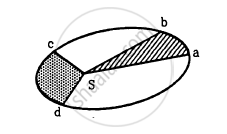Advertisements
Advertisements
प्रश्न
Supposing Newton’s law of gravitation for gravitation forces F1 and F2 between two masses m1 and m2 at positions r1 and r2 read F1 = – F2 = `- r_12/r_12^3 GM_0^2 ((m_1m_2)/M_0^2)^n` where M0 is a constant of dimension of mass r12 = r1 – r2 and n is a number. in such a case.
- the acceleration due to gravity on earth will be different for different objects.
- none of the three laws of Kepler will be valid.
- only the third law will become invalid.
- for n negative, an object lighter than water will sink in water.
उत्तर
a, c and d
Explanation:
Given, `F_1 = - F_2 = (-r_12)/r_12^3 GM_0^2 ((m_1m_2)/m_0^2)^n`
Acceleration due to gravity, `g = (|F|)/"mass"`
= `(GM_0^2 (m_1m_2)^n)/(r_12^2 (M_0)^(2n)) xx 1/(("mass"))`
Since. g depends upon the position vector, hence it will be different for different objects. As g is not constant, hence constant of proportionality will not be constant in Kepler's third law. Hence, Kepler's third law will not be valid.
As the force is of central nature. .....`[∵ "Force" ∝ 1/r^2]`
Hence, the first two of Kepler's laws will be valid.
For negative n, g = `(GM_0^2 (m_1m_2)^-n)/(r_12^2 (M_0)^(-2n)) xx 1/(("mass"))`
= `(GM_0^(2(1 + n)))/r_12^2 ((m_1m_2)^-n)/(("mass"))`
g = `(GM_0^2)/r_12^2 (M_0^2/(m_1m_2)) xx 1/"mass"`
As M0 > m1 or m2
g > 0, hence in this case situation will reverse i.e., an object lighter than water will sink in water.
APPEARS IN
संबंधित प्रश्न
Let us assume that our galaxy consists of 2.5 × 1011 stars each of one solar mass. How long will a star at a distance of 50,000 ly from the galactic centre take to complete one revolution? Take the diameter of the Milky Way to be 105 ly
Let the period of revolution of a planet at a distance R from a star be T. Prove that if it was at a distance of 2R from the star, its period of revolution will be \[\sqrt{8}\] T.
In the Following figure shows the elliptical path of a planet about the sun. The two shaded parts have equal area. If t1 and t2 be the time taken by the planet to go from a to b and from c to d respectively,

The orbit of a planet revolving around a star is _______.
Observe the given figure and answer these following questions.

The orbit of a planet moving around the Sun
- What is the conclusion about the orbit of a planet?
- What is the relation between velocity of planet and distance from sun?
- Explain the relation between areas ASB, CSD and ESF.
State Kepler’s laws.
The mass and radius of earth is 'Me' and 'Re' respectively and that of moon is 'Mm' and 'Rm' respectively. The distance between the centre of the earth and that of moon is 'D'. The minimum speed required for a body (mass 'm') to project from a point midway between their centres to escape to infinity is ______.
Both earth and moon are subject to the gravitational force of the sun. As observed from the sun, the orbit of the moon ______.
Out of aphelion and perihelion, where is the speed of the earth more and why?
Two planets A and B of equal mass are having their period of revolutions TA and TB such that TA = 2TB. These planets are revolving in the circular orbits of radii rA and rB respectively. Which out of the following would be the correct relationship of their orbits?
